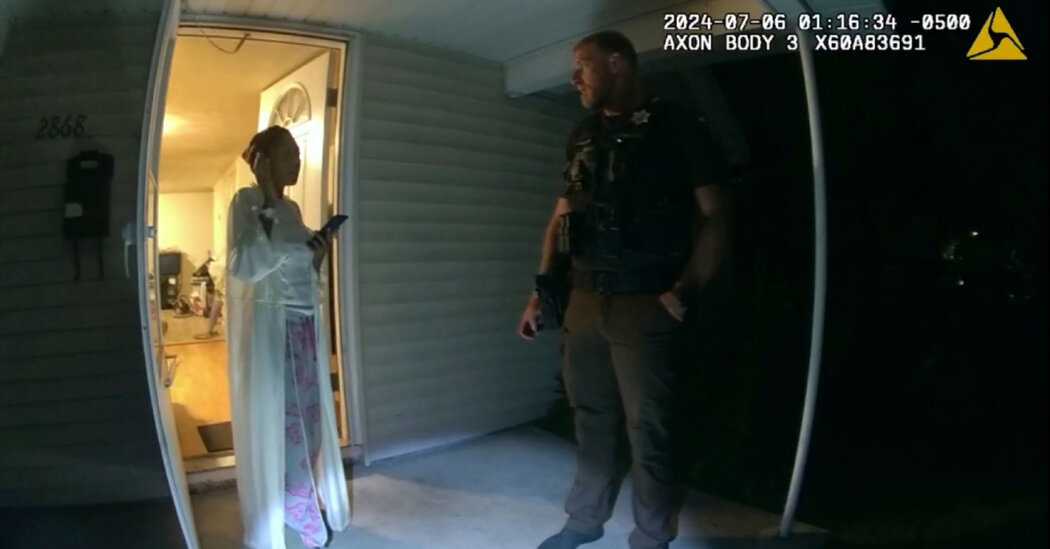Sonya Massey called 911 last year seeking help, concerned that someone was lurking outside her Illinois home.
When two sheriff’s deputies arrived on that summer night, they looked through the yard and found no one hiding. Then they knocked on the front door, engaged Ms. Massey in polite conversation and stepped inside her house.
The discussion remained cordial until after one of the deputies asked Ms. Massey to remove a pot of hot water from her stove. After picking up the pot, Ms. Massey said, “I rebuke you in the name of Jesus.” In a matter of seconds, the deputies pulled their guns and one of them, Sean Grayson, fatally shot Ms. Massey in the head.
The shooting prompted outrage in central Illinois, where protesters marched. Mr. Grayson, who was fired by the Sangamon County Sheriff’s Office, was charged with murder.
On Wednesday, jurors convicted Mr. Grayson of second-degree murder in Ms. Massey’s death, a relatively rare instance of an American law enforcement officer being convicted in an on-duty shooting.
During a trial in state court that lasted about a week, prosecutors accused Mr. Grayson of needlessly escalating the encounter with Ms. Massey, failing to follow his training and acting unreasonably when he shot her.
“We are here because of the actions of the defendant, and Sonya Massey is dead because of the defendant,” John Milhiser, the top prosecutor in Sangamon County, told jurors. “Send anyone else — anyone — and Sonya Massey is alive.”
Mr. Grayson, who took the witness stand in his own defense, said he feared for his safety when Ms. Massey, who was 36, lifted the pot of water.
“In this situation, unfortunately, I matched the threat level,” Mr. Grayson, 31, said in the wood-paneled courtroom in downtown Peoria, Ill., where he spoke calmly as he was questioned for about 45 minutes. He said the only tool he had to stop the threat was his weapon.
Prosecutions of police officers for on-duty shootings have become more common over the last decade after a series of high-profile killings that raised questions about how officers use force, especially against Black people. Ms. Massey was Black, and Mr. Grayson is white.
The growing use of body cameras, which recorded the shooting of Ms. Massey, and the proliferation of cellphone videos have sometimes called into question an officer’s account of a shooting and emerged as critical evidence in court. Still, prosecutors must clear a high legal bar, proving to jurors that the officer could not have reasonably feared death or great bodily harm. Even in the small subset of fatal shootings that lead to charges against an officer, acquittals and hung juries are common.
Mr. Grayson shot Ms. Massey just outside of Springfield, the capital of Illinois, where protesters gathered frequently after the shooting. The Sangamon County sheriff resigned over the incident, and local leaders created a Massey Commission to recommend policy changes related to “systemic racism and mistrust in law enforcement.” Some residents questioned why Mr. Grayson, who had twice been convicted of driving under the influence, had been hired in Sangamon County.
Against that backdrop, Mr. Grayson’s lawyers successfully asked for his trial to be moved out of Springfield. During several days of testimony in Peoria, about 70 miles north of Springfield, jurors watched the body camera footage, heard witnesses dissect Mr. Grayson’s actions and listened to Mr. Grayson’s former colleagues reflect on the shooting.
Anthony Mayfield, a former high-ranking official in the sheriff’s office, described watching the body camera footage for the first time with the sheriff.
“The room was silent,” Mr. Mayfield said. “You could hear a pin drop. I think everyone was shocked.”
Dawson Farley, the other deputy at Ms. Massey’s house at the time of the shooting, said Mr. Grayson had violated department policies and that Ms. Massey never said or did anything “that made me think she was a threat.”
After the shots were fired, Mr. Grayson discouraged Deputy Farley from retrieving a medical kit, though Deputy Farley did so anyway and attempted to help Ms. Massey.
Lawyers for Mr. Grayson said the shooting was justified, and that their client had reasonably feared for his safety when Ms. Massey grabbed the pot of water and said she was rebuking him.
Dan Fultz, one of the defense lawyers, told the jury that “what happened to Ms. Massey was tragic, but it was not a crime.”
Mitch Smith is a Chicago-based national correspondent for The Times, covering the Midwest and Great Plains.
The post Ex-Illinois Deputy Convicted in Fatal Shooting of Woman Who Had Called 911 appeared first on New York Times.




